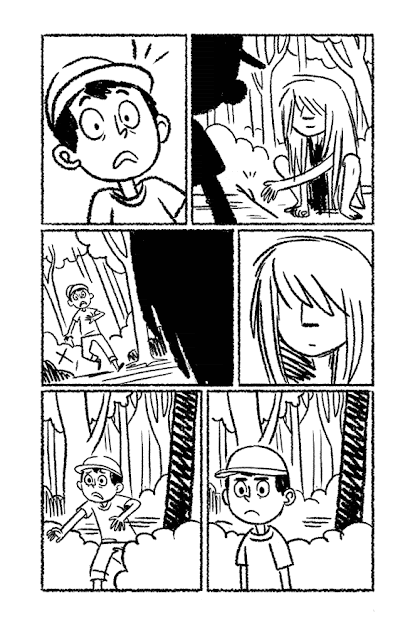
My artist's copy of Melissa Mendes's characters from "Where-wolf?":
A couple of sketches of character ideas in the style of Melissa Mendes:
Hope Larson: an example of her work from "Salamander Dreams":
Vera Bee: An example of her work from "What were you raised by wolves?":
My artist's copies and emulations of her style:
Comparison between
works of Melissa Mendes, Hope Larson and Vera Bee
Melissa Mendes has a charming art
style which verges on childlike in its simplicity and abandonment of accuracy
in proportions or anatomy, and yet evidences a kind of control to her seemingly
erratic and random use of brushstrokes that only truly skilled artists can
achieve. Her character designs,
particularly her recurring character Freddy and the two protagonists of “Where-Wolf?”,
ooze character and individuality. In
comparison, Vera Bee has a much more consistent art style, although her
character designs are equally unique and appealing. While, like Mendes’ work, Bee’s art style is quite
minimalist, and also in-keeping with a child-like quality through the way her
lines are crayon-like in texture, there is something much more mature and organised
to Bee’s work. On the other hand, Mendes
applies a grey tone to her work, while Bee’s is purely black and white and
representing shadow with child-like black squiggles.
In contrast, Hope Larson has a
style that is more mature than both Mendes and Bee’s works, not just in her
actual style, but the way she uses brush and ink, giving her lines a dreamy, water-like
flow. Unlike the other two also, in her graphic
novel “Salamander Dream”, she applies colour to her work rather than just
monotone; just the one colour other than black and white is used, however:
green. This helps further the natural
and dream-like quality to the art and the story, along with the abstract use of
human biology incorporated into the story and artwork, for example when the two
main characters hop from one giant blood cell to the next and float among DNA
helixes, as well as the general use of random dotted or wiggly lines that
sometimes appear in the background. These
can all easily be construed as visual metaphors to be interpreted by the
reader, and gives the comic a deep, mature and meaningful impression.
While it can be said that Mendes
and Bee’s works do not hold quite as much spiritual deepness as Larson’s, it
could be argued that it was not their intentions to be as such. In addition, while the story of Bee’s “What
were you raised by wolves?” is much more frank than “Salamander Dream” in its
general presentation and includes an overall more cartoony and humorous atmosphere,
it still holds a potent philosophical message to it that may leave the reader
thinking, as well as twists in the plot that the reader may find unpredictable and
emotionally stirring.











No comments:
Post a Comment